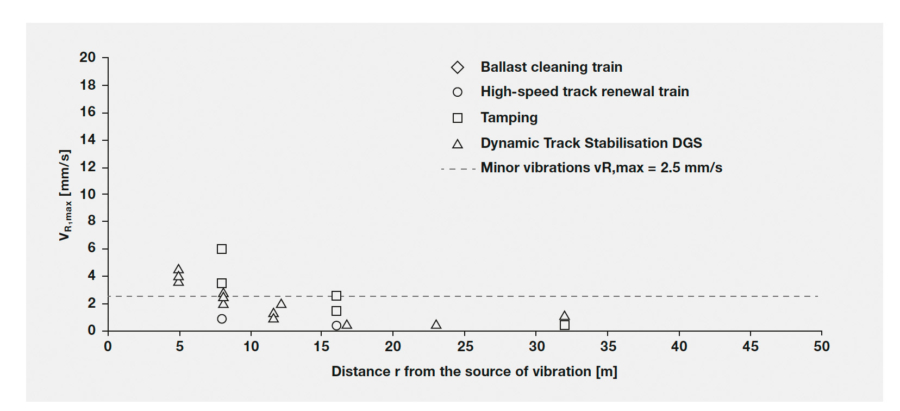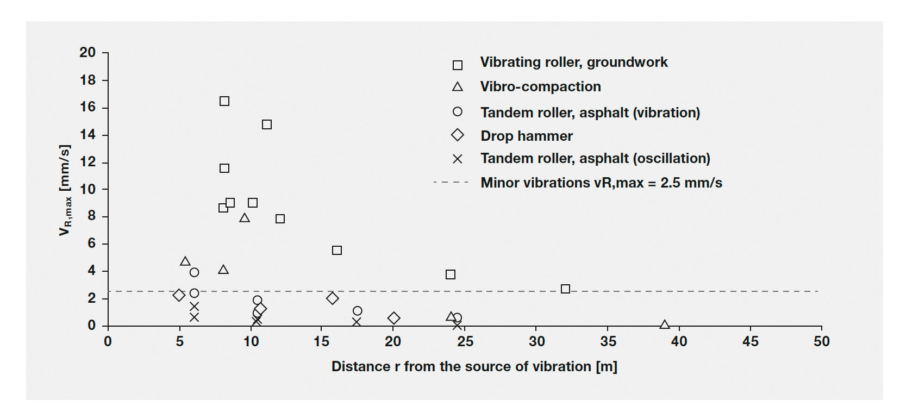
"In case of B 70 sleepers without under sleeper pads, the increase in LTR thanks to the DGS is approx. 30 %. In the case of B 07(with under sleeper pads), the frictional connection between ballast and sleeper is higher from the beginning. Nevertheless, the DGS causes the LTR to increase by about 10%. Systematically adjusting the machine’s parameter’s to accommodate the sleeper’s stiffness properties can be expected to increase output further.“"With the measurement results, the statement can be confirmed for the B 70 sleeper that the DGS corresponds to a consolidation of approx. 100,000 Lt. as a result of traffic load."
"The stabiliser achieves approx. 70 - 80 % of the original lateral track resistance (tamping only: 45 - 50 %)."
"Immediately after ballast bed cleaning or tamping, LTR values are reduced by 40 to 50 %. Dynamic track stabilisation increases the lateral track resistance by 30 - 40 %.""Dynamic track stabilisation anticipates stone re-arrangement processes and settlements during operation. This increases the number of contact points between the ballast stones thus reducing the peak pressure."
Dr. Ernest T. Selig, professor at the University of Massachusetts, has also analysed the effects of dynamic track stabilisation. He found that this method can compensate for 50 % of the reduction in LTR after tamping. According to Selig, dynamic track stabilisation also enables an additional increase in LTR compared to other methods of ballast compaction.
E. T. Selig, J. M. Waters: Track Geotechnology and Substructure Management. London: Telford, 1994
In a long-term study by Deutsche Bahn (DB) in Regensburg, 22 sections of track, each 100 m long, were alternately tamped with and without DGS. The measurements carried out afterwards at regular intervals showed that the fault deterioration rate of the stabilised sections increases slower than that of the non-stabilised sections, that the absolute fault level of the stabilised sections was smaller than that of the non-stabilised ones, and that dynamic track stabilisation led to an improvement of the situation in the area of long-wave faults.
Dynamische Gleisstabilisation – Ein Beitrag zur Kostensenkung. Plasser & Theurer, 1998
"An analysis of changes in granulation size did not indicate increased wear on the ballast bed as a result of the DGS."
"The study showed no discernible wear on the ballast bed due to the use of the DGS with regard to the grain size distribution based on the granulation size, the fine and ultra-fine grain, and also with regard to the grain shape index and the flatness index."
"Just like the field tests, the lab tests did not indicate any increase in ballast wear or wear of the rail pads and sleepers. In part, sleepers sustain temporarily increased bending stresses compared to normal operational loads. However, this short-term higher load is well below the threshold for structural damage to the sleeper resulting from a test procedure of the DBS 918 143 guidelines and DIN EN 13230-1:2016:11."
"No potential for damage could be identified in relation to the sleeper, the ballast, and the rail pads."
"In Austria, numerous tests and measurements were also carried out on the effect of dynamic track stabilisation on the fastenings. It could be demonstrated that this track treatment does not pose a risk to the rail fastenings."
"DB primarily studied the effect of track stabilisation on newly laid lines. The compaction effect, the influence on the track geometry, and the effects on structures and their surroundings were investigated. The results proved the high compaction effect and the low impact on the track surroundings."
"As structures and buildings tend to resonate around 23-25Hz if the DTS is kept between 30-35Hz, the risk is very low with the exception of structures incorporating cast-iron elements and tunnels which are avoided. DTS vibration does travel further laterally than trains or tampers but studies have shown these are very low and, after two metres, around 85% of the forces have dissipated. Studies have also shown that tamping can generate five-to-six times as much force vertically than DTS and generally, on the continent, the rule of thumb is if tamping is permitted then DTS is also acceptable."
G. Penfold: An introduction to intelligent DTS. Rail Infrastructure, Issue No. 148, January/February 2022, Seite 43-45, NPT Publishing, Newport, United Kingdom
The diagrams shown are based on a large number of vibration measurements. Fig. 1 shows the vibration emissions during track maintenance work. Compared to civil engineering work (Fig. 2), track maintenance work causes a significantly lower level of vibrations, for the most part.
As shown in Fig. 1, the vibrations caused by the DGS fall below the value for minor vibrations of vR,max = 2.5 mm/s already for a distance of around 8 m. This value corresponds to the threshold for vibration-sensitive buildings in Austria.


Source: RVE 04.02.04 (Guidelines and regulations for the railway industry - Vibration and secondary airborne noise during construction work on railway installations), Austrian Research Association for Roads, Railways and Transport, Vienna
In Germany, the threshold according to DIN 4150- 3: 1999-02, Table 1 is between 3 and 10 mm/s, depending on the frequency, i.e. considerably higher. The standard states: "Experience has shown that if the measures according to Table 1 are complied with, damage that reduces the serviceability of the building (see 4.5) will not occur. If damage nevertheless occurs, it is to be assumed that other causes are responsible."
It should also be noted that the unbalance exciters of the DGS generate a purely horizontal vibration. Measurements of vibration propagation during dynamic track stabilisation have repeatedly shown that horizontal vibrations generally experience greater damping, i.e. decrease more with distance, than vibrations in the vertical direction.
The vibrations caused by the DGS are already below the limit for minor vibrations at relatively short distances from the track.